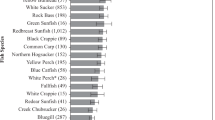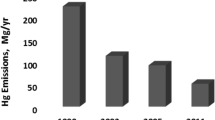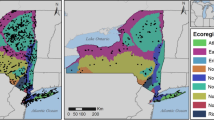Abstract
Mercury (Hg) contamination from a variety of point and non-point sources, including atmospheric inputs, is currently considered to be the most serious environmental threat to the well being of fish and wildlife resources in the southeastern United States. Fish consumption advisories have been issued in all ten states comprising the U.S. Fish and Wildlife Service's Southeast Region. Both freshwater and marine species have been affected with levels ranging as high as 7.0 ppm in some individuals. Many other species, including various species of reptiles, birds and mammals (including humans) are also contaminated. Impacts noted range from reproductive impairment to mortality.
Similar content being viewed by others
References
Cormier, K.: 1994, personal communication.
Delfino, J. J., Crisman, T. L., Gottgens, J. F., Rood, B. E. and Earle, C. D. A.: 1993.Spatial and temporal distribution of mercury in Everglades and Okefenokee wetland sediments, v. 1. Dept. of Environmental Engineering Sciences, Univ. of Florida, Gainesville. 140pp.
EA Engineering, Science, and Technology, Inc. (EAES&T): 1992.Remedial Investigation Report, Cold Creek Swamp, Mobile, Alabama.
Eisler, R.: 1987. Mercury hazards to fish, wildlife, and invertebrates: a synoptic review.U.S. Fish Wildl. Serv. Biol. Rep. 85(1.10). 90pp.
Folmar, H.: 1994, personal communication.
Geise, J.: 1994, personal communication.
Hale, M.: 1994, personal communication.
KBN Engineering and Applied Sciences (KBN): 1992.Mercury emissions to the atmosphere in Florida. Prepared for the Florida Department of Environmental Regulation, Tallahassee.
Ogden, J. C., Robertson, W. B., Davis, G. E. and Schmidt, T. W.: 1973.Poly chlorinated Biphenyls and Heavy Metals in Upper Food Chain Levels, Everglades National Park and Vicinity, South Florida Environ. Rep. DI-SFEP-74-16.
Roelke, M. E.: 1990.Florida panther biomedical investigation: Health and reproduction. Final Performance Report, Endangered Species Project E-1 II-E-6 7505, Florida Game and Fresh Water Fish Commission, Gainesville. 176pp.
Roelke, M. E., Schultz, D. P., Facemire, C. F., Sundlof, S. F. and Royals, H. E.: 1991.Mercury Contamination in Florida Panthers, A Report of the Florida Panther Technical Subcommittee to the Florida Panther Interagency Committee, 47pp.
Author information
Authors and Affiliations
Rights and permissions
About this article
Cite this article
Facemire, C., Augspurger, T., Bateman, D. et al. Impacts of mercury contamination in the southeastern United States. Water Air Soil Pollut 80, 923–926 (1995). https://doi.org/10.1007/BF01189745
Issue Date:
DOI: https://doi.org/10.1007/BF01189745




